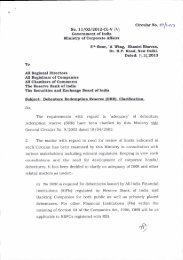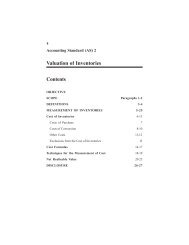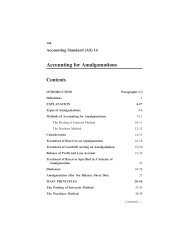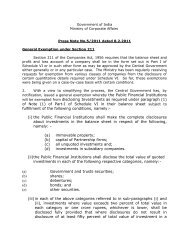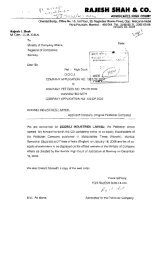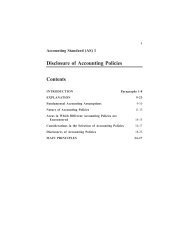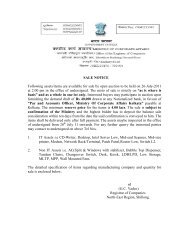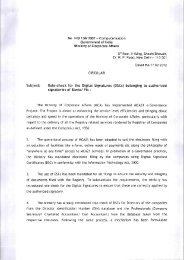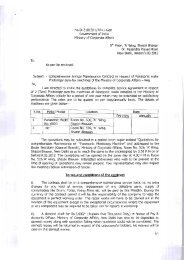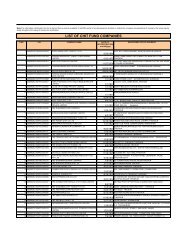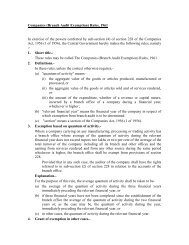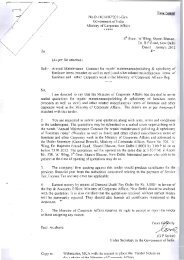Indian Accounting Standards(Ind AS) 1
Indian Accounting Standards(Ind AS) 1
Indian Accounting Standards(Ind AS) 1
You also want an ePaper? Increase the reach of your titles
YUMPU automatically turns print PDFs into web optimized ePapers that Google loves.
Impracticable Applying a requirement is impracticable when the entity<br />
cannot apply it after making every reasonable effort to do so.<br />
<strong><strong>Ind</strong>ian</strong> <strong>Accounting</strong> <strong>Standards</strong> (<strong>Ind</strong> <strong>AS</strong>s) are <strong>Standards</strong> prescribed under<br />
Section 211(3C) of the Companies Act, 1956.<br />
Material Omissions or misstatements of items are material if they could,<br />
individually or collectively, influence the economic decisions that users<br />
make on the basis of the financial statements. Materiality depends on the<br />
size and nature of the omission or misstatement judged in the surrounding<br />
circumstances. The size or nature of the item, or a combination of both,<br />
could be the determining factor.<br />
Assessing whether an omission or misstatement could influence economic<br />
decisions of users, and so be material, requires consideration of the<br />
characteristics of those users. The Framework for the Preparation and<br />
Presentation of Financial Statements issued by the Institute of Chartered<br />
Accountants of <strong>Ind</strong>ia states in paragraph 25 that ‘users are assumed to have a<br />
reasonable knowledge of business and economic activities and accounting and a<br />
willingness to study the information with reasonable diligence.’ Therefore, the<br />
assessment needs to take into account how users with such attributes could<br />
reasonably be expected to be influenced in making economic decisions.<br />
Notes contain information in addition to that presented in the balance sheet<br />
(including statement of changes in equity which is a part of the balance<br />
sheet), statement of profit and loss and statement of cash flows. Notes<br />
provide narrative descriptions or disaggregations of items presented in<br />
those statements and information about items that do not qualify for<br />
recognition in those statements.<br />
Other comprehensive income comprises items of income and expense<br />
(including reclassification adjustments) that are not recognised in profit or<br />
loss as required or permitted by other <strong>Ind</strong> <strong>AS</strong>s.<br />
The components of other comprehensive income include:<br />
(a) changes in revaluation surplus (see <strong>Ind</strong> <strong>AS</strong> 16 Property, Plant and Equipment<br />
and <strong>Ind</strong> <strong>AS</strong> 38) Intangible Assets);<br />
(b) actuarial gains and losses on defined benefit plans recognised in accordance<br />
with paragraph 92 and 129A of <strong>Ind</strong> <strong>AS</strong> 19 Employee Benefits;<br />
(c) gains and losses arising from translating the financial statements of a foreign<br />
operation (see <strong>Ind</strong> <strong>AS</strong> 21 The Effects of Changes in Foreign Exchange<br />
Rates);<br />
(d) gains and losses on remeasuring available-for-sale financial assets (see <strong>Ind</strong><br />
<strong>AS</strong> 39 Financial Instruments: Recognition and Measurement);<br />
(e) the effective portion of gains and losses on hedging instruments in a cash<br />
flow hedge (see <strong>Ind</strong> <strong>AS</strong> 39).<br />
Owners are holders of instruments classified as equity.<br />
Profit or loss is the total of income less expenses, excluding the<br />
components of other comprehensive income.<br />
4



